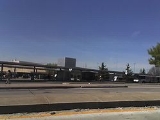
Layover
Encyclopedia
In transportation, a layover, also known as lays over or stopover, is some form of a break between parts of a single trip.
 A layover for a mass transit
A layover for a mass transit
line refers to the break the driver or the vehicle is given at the end of a trip before it starts operating its reverse route, or if the route is circular, before beginning its next trip. The layover has several benefits. These include:
The typical layover for a public bus line may be:
Sometimes, such a location may serve as a layover for more than one bus line. Many cities have specified locations, known as hubs or bus station
s, which serve as a layover point for several routes. In many cases, the layover point for one route may simply be an intermediate stop for another, where riders can transfer.
, train
, or inter-city bus
can refer to a break that a passenger must take between vehicles in a multi-vehicle trip. It refers to the time that is spent at a terminal after departing one vehicle and waiting to board the next. Many inter-city and international travelers face layovers during their journeys.
As in mass transit, the term layover is also applicable in long-distance travel for breaks taken by operators. A vehicle is said to be laying over after it finishes its route and is waiting prior to a return trip, or else it is taking a break to change crews or for the crew to rest.
In mass transit

Public transport
Public transport is a shared passenger transportation service which is available for use by the general public, as distinct from modes such as taxicab, car pooling or hired buses which are not shared by strangers without private arrangement.Public transport modes include buses, trolleybuses, trams...
line refers to the break the driver or the vehicle is given at the end of a trip before it starts operating its reverse route, or if the route is circular, before beginning its next trip. The layover has several benefits. These include:
- If the service has arrived at the final point behind its scheduled time, this allows for make-up time prior to starting the next trip, and therefore, better schedule adherence on the route.
- Allows for the operator of the vehicle to have a break without disrupting the service. If a shift change is necessary, this also can be done here without disrupting the service.
- In some cases, may allow for the vehicle being used to undergo a safety inspection.
The typical layover for a public bus line may be:
- A bus stop along the street in a location where the vehicle's presence will not be disruptive to the flow of traffic.
- An apartment complex or other similar development.
- A mall or shopping center parking lot or similar facility.
- A well-known landmark, such as a hospitalHospitalA hospital is a health care institution providing patient treatment by specialized staff and equipment. Hospitals often, but not always, provide for inpatient care or longer-term patient stays....
, college or university, or a government facility. - A subway station, commuter rail station or a park-and-ride lot.
Sometimes, such a location may serve as a layover for more than one bus line. Many cities have specified locations, known as hubs or bus station
Bus station
A bus station is a structure where city or intercity buses stop to pick up and drop off passengers. It is larger than a bus stop, which is usually simply a place on the roadside, where buses can stop...
s, which serve as a layover point for several routes. In many cases, the layover point for one route may simply be an intermediate stop for another, where riders can transfer.
In long-distance travel
Layover in long-distance travel by planeAir travel
Air travel is a form of travel in vehicles such as airplanes, helicopters, hot air balloons, blimps, gliders, hang gliding, parachuting or anything else that can sustain flight.-Domestic and international flights:...
, train
Rail transport
Rail transport is a means of conveyance of passengers and goods by way of wheeled vehicles running on rail tracks. In contrast to road transport, where vehicles merely run on a prepared surface, rail vehicles are also directionally guided by the tracks they run on...
, or inter-city bus
Greyhound Lines
Greyhound Lines, Inc., based in Dallas, Texas, is an intercity common carrier of passengers by bus serving over 3,700 destinations in the United States, Canada and Mexico, operating under the well-known logo of a leaping greyhound. It was founded in Hibbing, Minnesota, USA, in 1914 and...
can refer to a break that a passenger must take between vehicles in a multi-vehicle trip. It refers to the time that is spent at a terminal after departing one vehicle and waiting to board the next. Many inter-city and international travelers face layovers during their journeys.
As in mass transit, the term layover is also applicable in long-distance travel for breaks taken by operators. A vehicle is said to be laying over after it finishes its route and is waiting prior to a return trip, or else it is taking a break to change crews or for the crew to rest.

